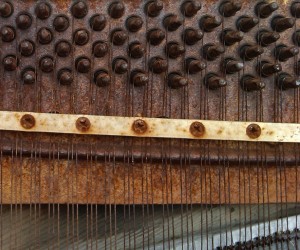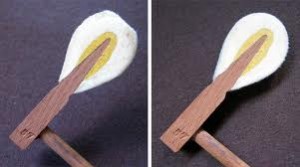Why do my piano strings break, or keep breaking? Here’s a question that I don’t hear that often, but one that may have an answer you may not have thought of. Until I studied piano technology, I wouldn’t have thought of it either. There are the obvious reasons, that we’ll discuss, but there are a couple that I would have not thought of had it not been brought to my attention.
So, what are some of the things that can cause a string to break?
If you think of anything that’s under tension, like a taught rope, a stretched rubber band, and things like that, we know that if the material is compromised in any way, that is the most likely reason for failure. For instance, we see in the movies the hero, (I’m thinking of Wesley from The Princess’ Bride), climbing the rope up the Cliffs of Insanity, and the villain is at the top feverishly cutting the rope to send the hero to their certain death. He’s not using an ax, but with a knife…strand at a time…weakening the rope until it finally cannot take the tension any longer.
While a single plain piano string doesn’t have strands, it can weaken to the point of breakage when things such as rust (from excessive moisture in the air) or mouse/cat urine that corrodes the metal on the string. Each of these are common reasons for string failure. Unless the damage is very localized, rust throughout the piano can cause many strings to begin breaking, either during tunings, during normal or excessive playing, or even during the day/night when no one is even playing it. That’s always a joy to hear when you’re not expecting it.

Rusty Strings and Tuning Pins
Another way strings fail is excessive tension. Just like a rope or rubber band, each can only take so much tension before it gives way. Have you ever pulled a rubber band back…just a little further to get the best flight distance…..just a little further……….snap! Yes, we’ve all done it, and it always surprises us when it happens.
A piano string can fail if excessive tension is placed on it, just like that rubber band. It can happen by playing excessively hard, or maybe by someone that tries to tune the piano but doesn’t know whether he is above or below pitch, gets disorientated, and before you know it, has raised the string too far leading to a broken string. Also, a common thing to happen to less experienced tuners, and sometimes to even experienced tuners, is for the tuning lever to be inadvertently placed on the wrong tuning pin, and thus raising the tension of a string that is muted off. Pitch doesn’t change, so they keep turning the pin and snap! Oops, only to find that they were turning the wrong pin. Sometime a loose tuning pin will cause a tuner to accidently apply too much pressure too quickly, raising the pitch too far and breaking a string. This happens usually when most of the piano has normal or tight tuning pins and the tuner’s muscle memory is used to applying a certain tension in order to get the tuning pin to move. Then when the tuner gets to a loose pin, that same tension will be way too much for that pin, causing it to raise quickly. Here’s a funny and practical example to illustrate that. My mother used to have a plastic bowl that we used for serving popcorn, however, it looked like cut glass. We had company over and everyone is passing the bowl around the table. When it came to our guest, they were expecting a heavy leaded crystal bowl, so they prepared their muscles to counter act the weight. Needless to say, their upward force was MUCH more than necessary for the light, plastic bowl, and popcorn went everywhere! Same thing happens sometimes to tuners.
Less common, maybe, are causes dues to defects in the string, or a defect in how the piano was built. Maybe the pressure or capo bar has too much “V” to it where the string passes over/under and when the string is hit hard with the hammer, that “V” acts like cutters on a pair of pliers, weakening the string at that spot over time until it finally gives way. Again, this is not very common, but on some models of pianos, I’ve heard that this was a problem.
Now to the reasons that I think piano owners should be aware of that maybe aren’t as obvious as those mentioned already.
There are two things that can contribute to string breakage beyond what was mentioned already, and that is worn or hard hammers, and a piano out of regulation (adjustment).
Hammers that are worn can get very flat on the crown where the string contacts the string. A properly shaped hammer has a sort of tear drop shape that is very symmetrical and the point that contacts the string is relatively small. The hammer hardness should allow for a good rebound off the string, kind of like a super ball…but definitely not hard like a marble or a soft like a cotton ball (forgive the extremes). When the hammer is flat and worn on the crown, there is more surface area, and more force applied to the string which can cause breakage.
It is VERY important to keep the hammers properly shaped and voiced, not only for the better tone it provides, but for the very health of the strings and other action parts that may be affected.
Another contributing factor is a piano out of regulation. When a piano is badly out of regulation, it throws many things out of whack, including how much force it takes to throw the hammer to the strings. You should not have to pound the keys to get a medium loud sound. If you do have to, this is a good sign that there is (what we technicians call) lost-motion. In plain english, this means that your key is moving downward a bit before the jack ever contacts the hammer to start the hammer’s movement toward the string. The more lost motion (slop as some call it), the less power you have, and the more you feel you need to bang the keys to get it to play.

Worn hammer vs Properly Shapped Hammer
Let-off is a VERY important adjustment that if not correct can lead to broken hammer shanks and sometimes broken strings. Let-off adjusts exactly how close the hammer can get to the string while being forced there by the key (pressing up on the jack, which presses on the hammer). As soon as let-off occurs, the jack trips out from under the hammer butt, or knuckle and the hammer finished it’s travel (about 1/16″ or so) to the string by inertia alone. If this setting is incorrect, the hammer will either let-off too soon, losing power, or it will not let-off soon enough…or not at all and the key then is slamming the hammer all the way to the string, full force and the hammer is not allowed to rebound by itself. This is called blocking, and usually will sound more like a “thud” than allowing the string to ring freely. This is because the hammer is being slammed, and held against the string for as long as the key is held down. This needs to be corrected immediately.
So, any one of these factors can cause string breakage, but in reality, it us usually a combination of several of these factors that cause strings to break. I am continually amazed at the number of 100+ year old pianos out there that still have their original strings and are tuned up making very acceptable music for their owners! I guess that I am amazed that more strings don’t break than do.
As long as we have strings, we will have strings that break…so go easy on your tuner if a string breaks while they are tuning. It does happen, and it’s usually not their fault. However, if you are having an issue of broken strings, you may need to talk with your technician to see if there are any repairs or regulation that needs to be taken care of.
Until next time…..make a joyful noise!